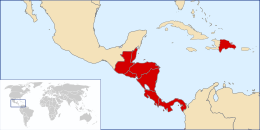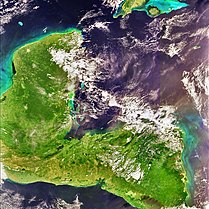Central American Integration System
| |
|---|---|
| Motto: "Dios, unión y libertad" (Spanish) "God, Union and Liberty" | |
| Anthem: La Granadera The Grenadier | |
 States in the Central American Integration System. | |
| Administrative center | |
| Official languages | Spanish |
| Type | Regional organization |
| Membership | 8 states 11 regional observers 21 extraregional observers |
| Leaders | |
• President pro tempore | Johnny Briceño |
• General Secretary | Werner Isaac Vargas Torres |
| Legislature | Central American Parliament |
| Establishment | |
| 20 December 1907 | |
• ODECA | 14 October 1951 |
• CACM | 13 December 1960 |
• SICA | 13 December 1991 |
| Area | |
• Total | 572,510 km2 (221,050 sq mi) |
| Population | |
• 2009 estimate | 51,152,936 |
• Density | 89.34/km2 (231.4/sq mi) |
| GDP (PPP) | 2010 estimate |
• Total | $506.258 billion |
• Per capita | $9,898.17 |
| GDP (nominal) | 2010 estimate |
• Total | $266.213 billion |
• Per capita | $5,205.45 |
Website sica.int | |
| Part of a series on |
| Central America |
|---|
 |
The Central American Integration System (Spanish: Sistema de la Integración Centroamericana, or SICA) has been the economic and political organization of Central American states since 1 February 1993. On 13 December 1991, the ODECA countries (Spanish: Organización de Estados Centroamericanos) signed the Protocol of Tegucigalpa, extending earlier cooperation for regional peace, political freedom, democracy and economic development. SICA's General Secretariat is in El Salvador.
In 1991, SICA's institutional framework included Guatemala, El Salvador, Honduras, Nicaragua, Costa Rica and Panama. Belize joined in 1998 as a full member, while the Dominican Republic became an associated state in 2004 and a full member in 2013. Mexico, Chile and Brazil became part of the organization as regional observers, and the Republic of China, Spain, Germany, Georgia and Japan became extra-regional observers. SICA has a standing invitation to participate as observers in sessions of the United Nations General Assembly,[1] and maintains offices at UN Headquarters.[2]
Four countries (Guatemala, El Salvador, Honduras, and Nicaragua) experiencing political, cultural and migratory integration have formed a group, the Central America Four or CA-4, which has introduced common internal borders and the same type of passport. Belize, Costa Rica, Panama and the Dominican Republic subsequently joined the CA-4 for economic integration.
- ^ "United Nations list of observing international organizations". un.org. Retrieved 4 April 2018.
- ^ "El Sistema De La Integracion Centroamericana - New York". www.sgsica-ny.org. Archived from the original on 30 August 2011. Retrieved 4 April 2018.

